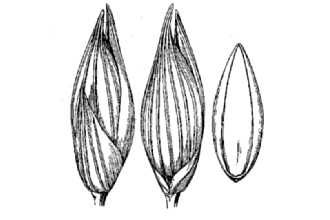Havard's Panicgrass
Scientific Name: Panicum havardii Vasey

| General Information | |
|---|---|
| Usda Symbol | PAHA2 |
| Group | Monocot |
| Life Cycle | Perennial |
| Growth Habits | Graminoid |
| Native Locations | PAHA2 |
Plant Guide
Use a soil moisture meter to monitor the soil moisture where Havard's Panicgrass is planted.
Fact Sheet
Alternate Names
Havard’s panicgrass, Havard’s panicum, Havard panic
Uses
Havard panicum grows naturally on deep, active sand dunes and arroyos. It is useful for the stabilization of active sand dunes and arroyos. Harvard panicum produces low forage yield, and the forage is coarse and unpalatable when plants are in the mature stage. But, cattle will eat the forage of this grass when plants are in the early vegetative stages.
Status
Please consult the PLANTS Web site and your State Department of Natural Resources for this plant’s current status (e.g. threatened or endangered species, state noxious status, and wetland indicator values).
Description
Havard panicum is a perennial, warm-season, native grass with stout solitary culms and rhizomes elongated and scaly. Inflorescence is a panicle which is 7 to 15 inches long. The panicle is open, about 7 to 15 inches wide with an ovate shape. Panicle branches are stiff. Seeds are nearly twice the size of switchgrass. Culms are decumbent and 25 to 63 inches long. Culm-internodes are covered with a waxy coating that gives a blue-green color and are hairless. Leaf sheaths are without a keel and without hairs on the leaf surface. Ligules are a ciliate membrane, 0.08 to 0.16 inches long.
Adaptation
Havard panicum grows in arroyos and sand hills of western Texas, southern New Mexico and northern Mexico (Hitchcock 1935). This grass, like giant sandreed (Calamovilfa gigantea), and blowout grass (Redfieldia flexuosa) are among the first native species to show up as stabilizers on deep, active, sand dune areas. Giant sandreed and blowout grass are common over a wide section of the southern United States, but Havard panicum is found only in Texas, southern New Mexico, and northern Mexico, in arroyos and on the extensive dune areas. It is prevalent in Ward, Crane, Winkler, Ector, and Andrews Counties of western Texas.
Establishment
Havard panicum is established from seed in the spring by either broadcasting on the sand dunes or sowing with a small grass drill at a depth of ¼ inch on flatter surface dune areas. Applying a thin layer of hay mulch or an erosion control type mat after seeding will retain moisture when it rains to aid in the seed germination. An alternative is to propagate Havard panicum from rhizomes, harvested during the previous year, in the greenhouse in 1 gallon pots and transplant these rhizomes in the spring to sandy sites. Irrigation of these sandy sites would be necessary during the first growing season.
Management
Havard panicum is valuable for controlling erosion on deep sands subject to severe wind erosion, When used for pasture the grazing value of the havard panicum can be fair at early vegetative stages, before the inflorescence stage, when plants are fresh with new growth, Do not overgraze and leave enough plant material for regrowth, Begin grazing when plants reaches a height of 12 inches; plants should not be grazed below a stubble height of 6 to 8 inches, At the James E, Use soil moisture sensors to measure the soil moisture of Havard's Panicgrass., “Bud” Smith Plant Materials Center near Knox City, Texas, the Havard panicum grown for seed production is swathed and baled for hay, after the seeds are harvested,
